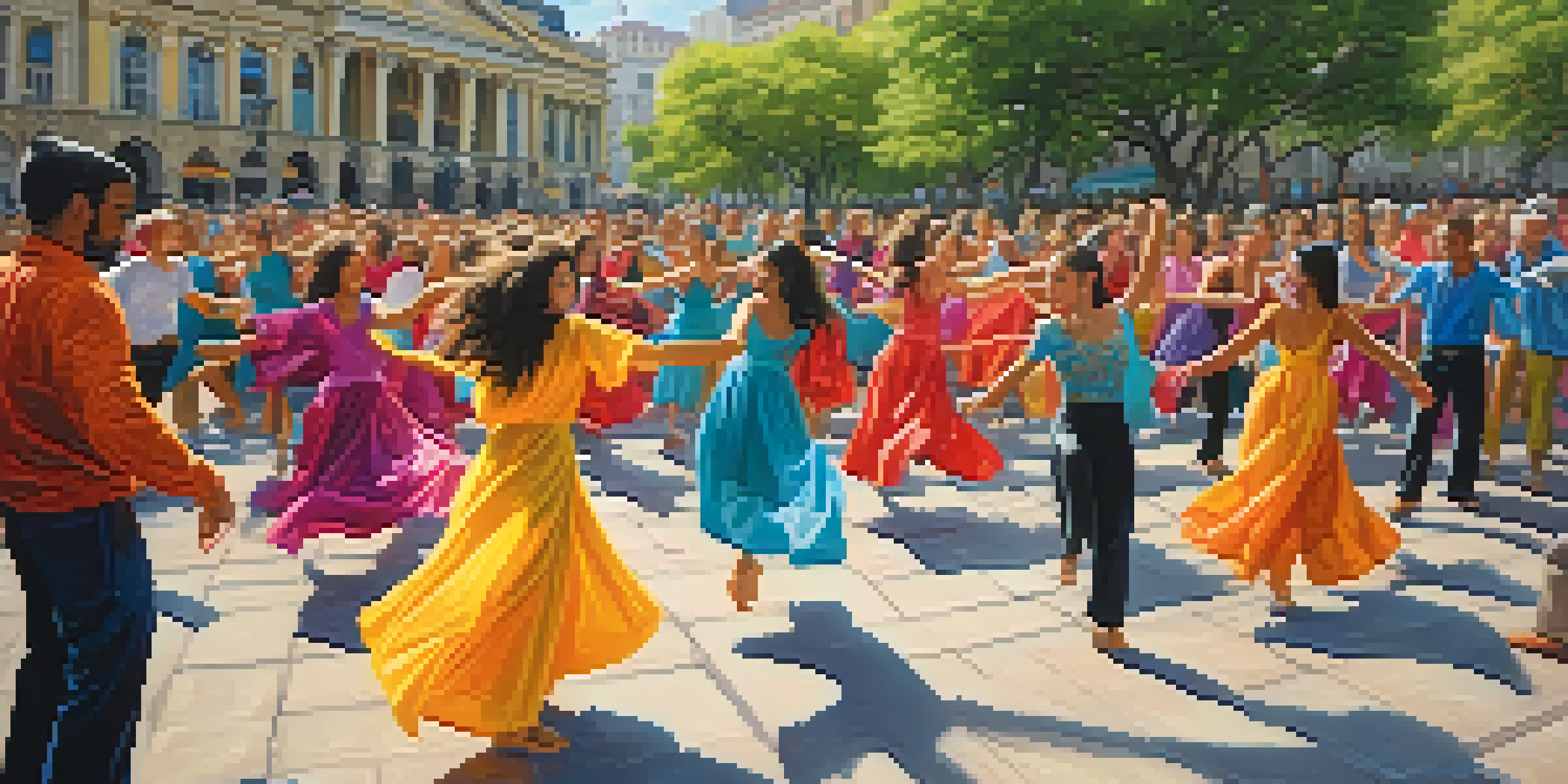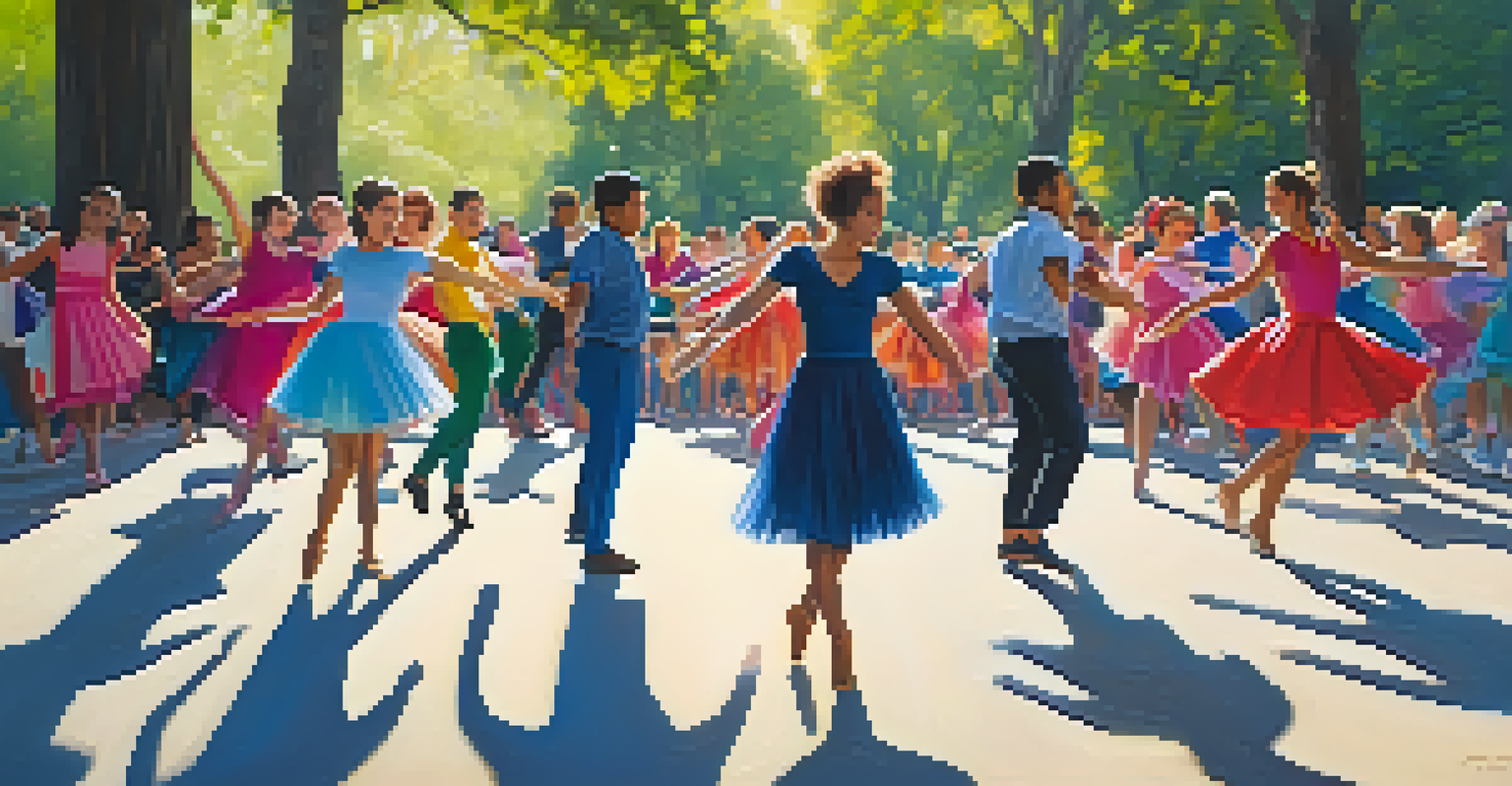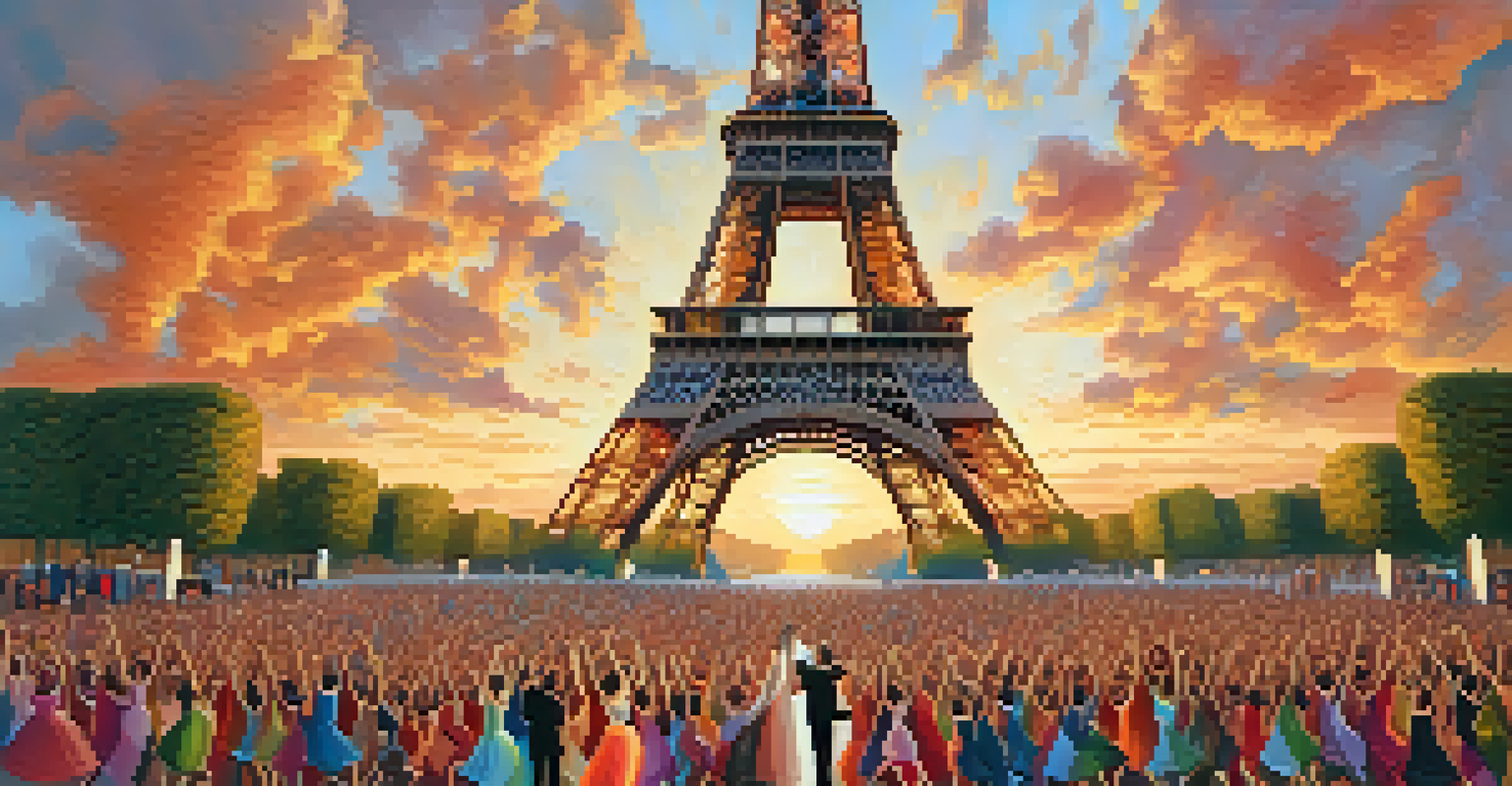Dance Flash Mobs: Spontaneous Activism in Public Spaces

What is a Dance Flash Mob? A Brief Overview
A dance flash mob is a spontaneous gathering of people who perform a choreographed dance in a public space. Often organized through social media, these events surprise unsuspecting onlookers, creating a lively atmosphere. The phenomenon gained popularity in the early 2000s, showcasing how art can emerge from everyday life.
Dance is the hidden language of the soul.
Participants usually rehearse a specific routine before the event, coordinating via online platforms and word of mouth. This collaborative effort turns an ordinary moment into something extraordinary, capturing the attention of passersby. Ultimately, it’s about bringing people together to celebrate creativity and community.
Flash mobs have evolved beyond mere entertainment; they can serve as a form of expression and activism. With a catchy tune and synchronized moves, these gatherings can convey powerful messages, whether it's for social justice, charity, or simply to spread joy.
The Historical Roots of Flash Mobs in Activism
While flash mobs may seem like a modern invention, their roots can be traced back to earlier forms of public art and activism. Movements like the 1960s counterculture used spontaneous gatherings to promote social change and challenge societal norms. These early examples laid the groundwork for today’s flash mobs as a tool for expression.

One notable instance is the 1969 Stonewall Riots, where the LGBTQ+ community came together in a sudden, powerful uprising. Just as flash mobs today bring people together for a cause, these historical events highlighted the importance of unity in the fight for rights.
Dance Flash Mobs Unite Communities
These spontaneous gatherings foster creativity and bring people together to celebrate important social issues.
The evolution of technology and social media has further amplified the reach of these movements. In today's digital age, organizing a flash mob is just a click away, allowing activists to mobilize quickly and efficiently to address pressing issues.
The Role of Social Media in Organizing Flash Mobs
Social media has transformed the way flash mobs are organized and executed. Platforms like Facebook, Instagram, and TikTok enable organizers to reach a wide audience, making it easier to gather participants. A simple post can ignite interest, turning a small group of friends into a crowd of hundreds.
Art is the most beautiful of all lies.
The viral nature of social media also means that flash mobs can gain attention far beyond their immediate location. Videos shared online can inspire similar events across the globe, creating a ripple effect of activism and creativity. This connectivity fosters a sense of community among those who share a passion for performance.
Additionally, hashtags and trending topics can help amplify the message behind the flash mob. By associating their performance with a specific cause, participants can draw attention to issues that matter to them, using the power of dance to inform and engage.
Impact of Dance Flash Mobs on Local Communities
Dance flash mobs can have a significant impact on local communities, fostering a sense of belonging and creativity. When participants take to the streets, they often attract attention not just for their performance, but for the message behind it. This can lead to conversations about important social issues that resonate within the community.
Moreover, these spontaneous events can help local artists showcase their talents and connect with their audience. Community members may discover new forms of expression and be inspired to participate in future artistic endeavors. In this way, flash mobs become a catalyst for cultural exchange.
Social Media Drives Flash Mobs
Platforms like Facebook and Instagram make it easy to organize and promote flash mobs, amplifying their reach and impact.
In many cases, the positive energy generated by a flash mob can uplift an entire neighborhood. The joy and excitement of watching or participating in a dance performance can create lasting memories, making public spaces feel more vibrant and inviting.
Challenges and Criticisms of Flash Mobs
Despite their fun and engaging nature, dance flash mobs are not without challenges. Organizers must navigate legal and logistical hurdles, such as obtaining permits and ensuring the safety of participants and spectators. In some cases, flash mobs have faced backlash from local authorities who view them as disruptive.
Critics also argue that the spontaneity of flash mobs can sometimes overshadow their intended message. When the focus shifts too much toward entertainment, the deeper meanings behind the performance may be lost. It’s crucial for organizers to strike a balance between fun and purpose.
Additionally, some people may feel excluded from these events, especially if they are not aware of the planning. Ensuring inclusivity can be a challenge, but it's essential for fostering a sense of community and shared experience.
Famous Dance Flash Mobs that Made Headlines
Over the years, several dance flash mobs have garnered significant media attention, showcasing their potential for activism. One of the most notable examples occurred in 2010 when a flash mob performed 'Don't Stop Believin'' at the San Francisco airport, promoting a sense of hope and unity during tough economic times.
Another memorable flash mob happened in 2012, when hundreds of dancers gathered at the Eiffel Tower to perform a choreographed routine to Pharrell Williams' 'Happy.' This joyful celebration attracted tourists and locals alike, spreading positivity and encouraging people to embrace life.
Challenges of Organizing Flash Mobs
Despite their fun nature, flash mobs face legal hurdles and the risk of losing their intended message amid the entertainment.
These high-profile events not only entertain but also inspire others to participate in similar activities. They demonstrate the power of dance as a universal language that can bridge gaps and bring people together for a common cause.
How to Get Involved in Dance Flash Mobs
Getting involved in a dance flash mob is easier than you might think! Start by searching local social media groups or community boards to find upcoming events. Many organizers welcome new participants, regardless of skill level, making it a great opportunity to learn and connect with others.
If you’re feeling adventurous, consider organizing your own flash mob! Choose a song that resonates with a cause you care about, create a simple dance routine, and spread the word through social media. Don’t forget to encourage friends and family to join in, as the more, the merrier!

Finally, remember to embrace the spirit of fun and creativity. Whether you're dancing or simply watching, your presence contributes to the vibrant atmosphere of a flash mob. It's all about celebrating community, art, and the power of collective action.